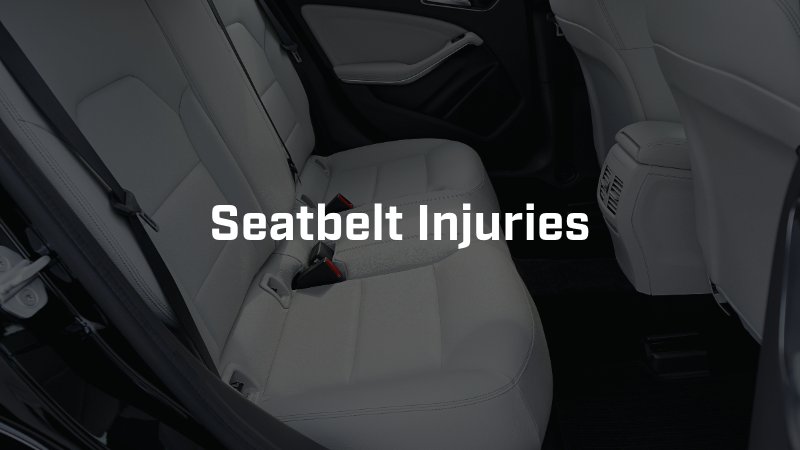Seatbelts used to be controversial. For anyone who was around when seat belt laws started becoming universal in states in the 1970s and into the 1980s, you’ll remember the harsh debate over whether or not people should be forced to wear seatbelts.
The overall consensus, now, is that, yes, seatbelts save lives, and they should be required. You may still have the knucklehead or two that refuses to wear one, but the data overwhelmingly shows the benefits of these important safety devices.
However, seatbelts can also cause injuries in their own right, even as they prevent what would likely be much more serious trauma from occurring.

Common Types of Seatbelt Injuries
Seatbelt injuries vary depending on the crash’s severity, the angle of impact, and the positioning of the seatbelt. Here are some of the most frequent types of injuries linked to seatbelt use in car accidents:
- Bruising and abrasions. The most common seatbelt injury is bruising, which occurs when the belt presses tightly against the skin, particularly across the chest and abdomen. Bruising is typically mild, but in severe crashes, it can extend to deeper tissues and muscles, resulting in painful, long-lasting bruises.
- Fractured ribs. In a high-impact collision, seatbelts can exert enough pressure to fracture or break ribs. Rib fractures are not only painful but can also be dangerous if bone fragments puncture the lungs or other internal organs.
- Whiplash injuries. Seatbelts prevent the body from moving forward but do not fully restrict the head and neck. This restraint can cause whiplash, where the neck and head snap forward and back, damaging muscles and ligaments in the neck.
- Abdominal and organ injuries. The lap portion of the seatbelt can press deeply into the abdomen during a crash, potentially causing injury to internal organs such as the liver, spleen, and intestines. This is particularly dangerous as these injuries may not be immediately apparent but can lead to severe complications if left untreated.
- Shoulder and clavicle injuries. The shoulder strap can create fractures or dislocations in the collarbone, particularly if the impact is strong. This can lead to limited shoulder movement and extended recovery times.
Less Common but Severe Seatbelt Injuries
While the above injuries are the most frequent, some rarer but serious conditions can also result from seatbelt use:
- Seatbelt syndrome. This refers to a combination of injuries caused by seatbelts, typically including soft tissue damage, abdominal injuries, and spinal fractures. This syndrome occurs in particularly violent crashes and may require immediate medical attention due to the risk of internal injuries.
- Spinal injuries. While less common, the force exerted by a seatbelt during a crash can cause spinal compression fractures, especially in the lower back. These injuries can impact mobility and may require surgery or extensive rehabilitation.
- Intestinal injuries in children. Children are more vulnerable to seatbelt-related injuries, particularly if they are not seated in age-appropriate car seats. Seatbelts designed for adults can press directly on a child’s abdomen, increasing the risk of intestinal injury.
Factors That Increase the Risk of Seatbelt Injuries
Several factors can make seatbelt injuries more likely in the event of a crash. Recognizing these risk factors can help you minimize the chance of injury.
- Improper positioning. Wearing a seatbelt incorrectly increases the risk of injury. The shoulder belt should always go across the chest and shoulder, not behind the back or under the arm. The lap belt should rest low across the hips, not the stomach, to prevent abdominal injuries.
- High-speed impacts. The higher the speed at the time of the collision, the greater the force the seatbelt must exert to hold you in place. High-speed impacts, therefore, increase the risk of severe seatbelt injuries, including fractures and internal trauma.
- Defective seatbelts. If a seatbelt is defective, it may not lock or hold properly during an accident, putting passengers at greater risk. In some cases, seatbelts have been known to unlatch during a crash or fail to restrain the passenger adequately. If you suspect a defect, it is essential to consult with an attorney who can investigate and hold the manufacturer accountable if necessary.
Compensation for Seatbelt Injuries After a Car Accident
If you have suffered seatbelt injuries due to a car accident caused by another party’s negligence, you may be entitled to compensation. This compensation can help cover medical expenses, lost income, pain and suffering, and more. Working with a Phoenix car accident lawyer can provide you with the legal support you need to navigate the claims process and ensure that your injuries are adequately documented and valued.
A Phoenix injury attorney can assist in various ways, including:
- Investigating the accident. They can gather evidence of the crash, including witness statements and accident reports, to establish liability.
- Documenting injuries. Your attorney will work with medical experts to document the extent of your injuries and gather the necessary evidence to demonstrate their impact on your life.
- Negotiating with insurance companies. Insurance adjusters may attempt to downplay the severity of seatbelt injuries. An attorney can advocate for a fair settlement on your behalf.
